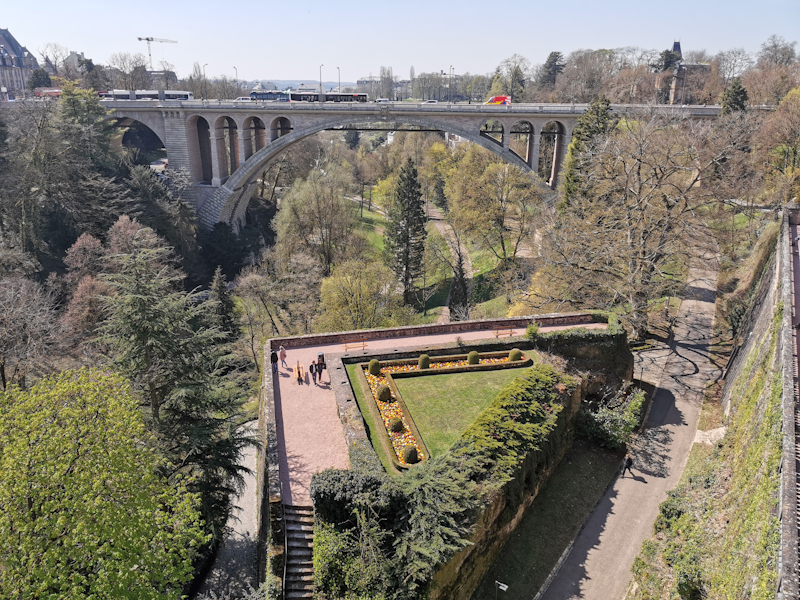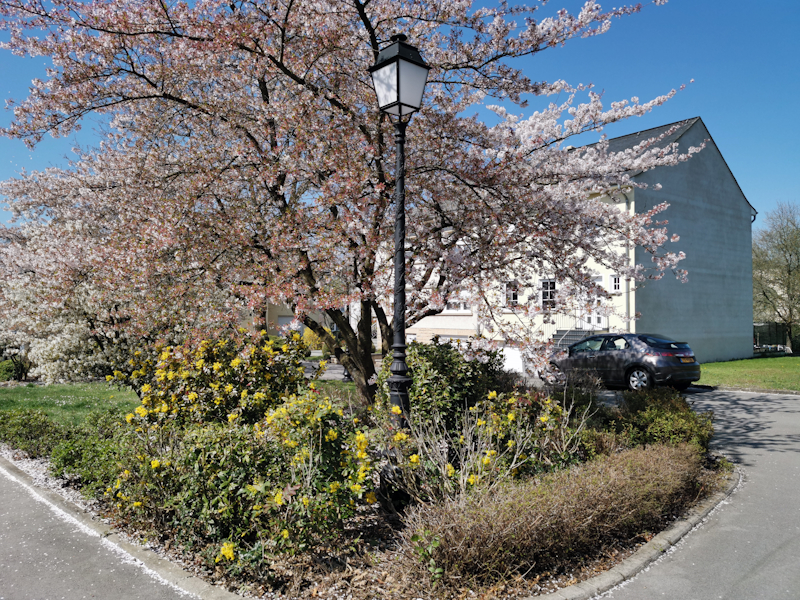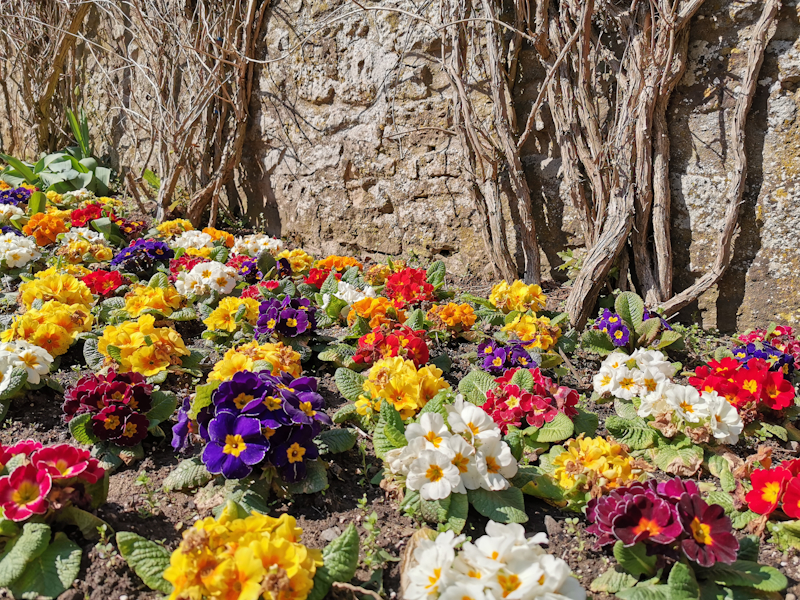The Huawei P30 & P30 Pro Reviews: Photography Enhanced
by Andrei Frumusanu on April 18, 2019 9:00 AM EST- Posted in
- Mobile
- Smartphones
- Huawei
- P30
- P30 Pro
Camera - Daylight Evaluation: Dynamic Range & Detail

[ P30 Pro ] - [ P30 ]
[ P20 Pro ] - [ P20 ]
[ Mate 20 Pro ] - [ S10+ (S) ]
[ S10+ (E) ] - [ S9+ (S) ] - [ G8 ]
[ G7 ] - [ V40 ] - [ View20 ]
[ OnePlus 6T ] - [ Pixel 3 ] - [ iPhone XS ]
Between the four Huawei 40MP sensor phones, the P30 Pro, P30, P20 Pro and Mate 20 Pro all produced vastly different results in their 10MP auto mode. The P30 Pro here produced a quite washed out image which was too desaturated, the P30 on the other hand was nearer to the actual scene. Both results have very different HDR processing compared to the P20 Pro which had a lot stronger processing going for it. The P30s produced more natural luminance gradients with less HDR artefacts.
Looking at the native 40MP results, all the phones have too dark results as the sensors lack dynamic range in this mode. What is also evident is that both the P30 units have trouble with resolving detail as well as the P20 Pro or the Mate 20 Pro. On one hand part of this is explained by the new optics with the wider aperture, particular some shots of the P30 Pro we see the shallower depth of field affecting details. On the other hand, this loss of detail is even present within the focal plane, and here the only explanation I have is that it’s either due to processing or simply the new RYYB sensor which isn’t able to achieve the same colour spatial resolution as the previous generation Bayer sensor.

[ P30 Pro ] - [ P30 ]
[ P20 Pro ] - [ P20 ] - [ Mate 20 Pro ]
[ S10+ (S) ] - [ S10+ (E) ] - [ S9+ (S) ]
[ G8 ] - [ G7 ] - [ V40 ]
[ View20 ] - [ OnePlus 6T ] - [ Pixel 3 ] - [ iPhone XS ]
This next scene with the cherry tree better demonstrates the weaknesses of the optics on the P30 Pro. Its wider aperture of f/1.6 versus the f/1.8 is visible in the outer parts of the image as things get blurred out because of chromatic aberrations. Again, this scene was extremely bright with the sun directly overhead. Both P30s in their native resolution showcase worse optics than the Mate 20 Pro which is able to get clean details throughout the scene without any haze. Again some of the loss in detail can’t be explained just by the optics, and here I think it’s again the sensor which might have a worse DTI implementation has Huawei’s previous 40MP units. These issues aren’t immediately visible in the 10MP shots as things become quite small.
This is a good opportunity to talk about Huawei’s Master AI mode; this had existed in past flagships in various iterations, but now Huawei has finally put a UI button switch directly in the camera interface. Last year this mode was a complete disaster with cartoonish contract and vignette effects, however starting with the Mate 20s it was a lot more toned down. For the P30s, I’ve found that in the vast majority of times it’s beneficial, such as in this sot a slightly bluer sky and a little brighter highlights.

[ P30 Pro ] - [ P30 ]
[ P20 Pro ] - [ P20 ] - [ Mate 20 Pro ]
[ S10+ (S) ] - [ S10+ (E) ] - [ S9+ (S) ]
[ G8 ] - [ G7 ] - [ V40 ]
[ View20 ] - [ OnePlus 6T ] - [ Pixel 3 ] - [ iPhone XS ]
This road scene again shows the optics differences between the P30 Pro, P30 and Mate 20 Pro. The larger aperture of the P30 Pro results in hazy details around the centre of the image, while the P30 doesn’t suffer as much. Still the Mate 20 Pro is far ahead of both in the optics and remains extremely sharp.
Again in the default mode the exposures are a bit too bland for the fact that the sun is directly overhead at noon – the AI mode again brings back a bit of saturation and highlights. Samsung and LG do a lot better here.

[ P30 Pro ] - [ P30 ]
[ P20 Pro ] - [ P20 ]
[ Mate 20 Pro ] - [ S10+ (S) ]
[ S10+ (E) ] - [ S9+ (S) ] - [ G8 ]
[ G7 ] - [ V40 ] - [ View20 ]
[ OnePlus 6T ] - [ Pixel 3 ] - [ iPhone XS ]

[ P30 Pro ] - [ P30 ]
[ P20 Pro ] - [ P20 ] - [ Mate 20 Pro ]
[ S10+ (S) ] - [ S10+ (E) ] - [ S9+ (S) ]
[ G8 ] - [ G7 ] - [ V40 ] - [ View20 ]
[ OnePlus 6T ] - [ Pixel 3 ] - [ iPhone XS ]
In the last scene we again see evident shallow depth of field of both units, with the P30’s focal plane being slightly nearer in this autofocus shot. On the P30 Pro you need to be aware of the new optics, as they can be a double-edged sword. On one hand it can give you natural blurring, but in some cases if you do not want the effect, you can’t do nothing about it, as opposed to say Samsung’s dual-aperture main camera.
The 40MP mode here is useless as while it captures a lot of detail, the dynamic range is severely lacking. Also this scene showcases the bad aspects of the AI mode; colours get far too saturated and unnatural.
P30 Pro & P30 Daylight Evaluation Conclusion
Overall, Huawei’s strategy in their camera hasn’t changed and what we’re seeing in the P30 Pro and P30 in terms of daylight capture continues the trends we saw in the P20s and Mate 20s.
In terms of versatility in different scenarios, the P30s are king. The inclusion of the trifecta of wide angle, regular and telephoto lenses means that you’ll be able to have the right camera at hand in the vast majority of cases. However this was also true for the Mate 20 released late last year.
So how do the P30’s differentiate? Well the P30 doesn’t try to do things much differently, and its camera setup is in line with what we found on the P20 Pro and Mate 20 Pro. This is not to say it’s bad, and the 3x telephoto zoom module is still unique to Huawei.
The P30 Pro’s 5x optical zoom module tries to do something special, and yes indeed it can capture things farther than any other phone out there. I do however have concerns on just exactly how useful this is in everyday usage, as I rarely find myself needing to zoom in quite that far. At 2x digital magnification/crop the P30s still hold up against the optical 2x modules because of the 40MP sensors, however going to 3x zoom we find that the P30 Pro finds itself in a quality gap until you go further to 5x. The bigger concern here is the f/3.4 aperture lens of the new module, and it’s evident that while it gets a lot of detail, its exposure isn’t quite the best.
The wide angle modules on both phones are great, but like on the Mate 20s, the Pro version has a better sensor that is able to capture more detail as well as have better dynamic range.
Processing on the P30s has changed a lot compared to the Mate 20s, however this is not always for a benefit. Sometimes HDR processing is a regression over the Mate 20s, however most of the time it does a better job. Colour rendition is also something the P30s sometimes seem to struggle and I did find some shots a tad too undersaturated, something that in the vast majority of cases is fixed by enabling the AI mode.
Speaking of the AI mode, compared to last year’s P20s, it’s a gigantic leap. This year it’s much more subtle and in the vast majority of cases it’s for the benefit of the scene. It’s only on rare occasions where it does go overboard.
Finally, the main optics of the P30 Pro and P30 feel like a slight disappointment to me. Particularly in the 40MP modes it’s evident that the lenses have seen downgrades compared to what we had in the Mate 20 Pro. The P30 Pro’s large f/1.6 aperture suffers more than the f/1.8 unit of the P30. In 10MP mode this is less immediately visible, however upon closer inspection it does result in less detail even in this mode.
I’m not certain if it’s due to the processing or the sensor, but even within the focal plane we’re seeing less detail sharpness. I very much think this is partly due to the new RYYB sensor which seemingly has lesser DTI (deep trench isolation) between the pixels.
Overall for daylight pictures, I come to the same conclusion I had on the P20 Pro, Mate 20 Pro and View20: These high megapixel sensors do not always achieve the best quality in well-lit scenarios. Huawei also needs to work on the composition consistency between the different camera sensors, there’s too many scenarios where the wide-angle, main camera as well as the zoom lens produce much too different results.










85 Comments
View All Comments
Speedfriend - Thursday, April 18, 2019 - link
Andrei, in your conclusion, your say battery life of the S10+ is much better yet I see forums full of people complaining of terrible battery life. Has this now been fixed with updates?Andrei Frumusanu - Thursday, April 18, 2019 - link
Yes the latest firmware has resolved the idle drain issue.austinsguitar - Thursday, April 18, 2019 - link
^ can confirmed they did some magic last update. thanks samsung.niva - Thursday, April 18, 2019 - link
Wow, Samsung updates their phones? That's something new. Don't get used to it.philehidiot - Thursday, April 18, 2019 - link
I've got an S8 and it gets regular updates. Mostly for security but it got Android Pi recently as well as a host of other updates including camera software which added a few new features. Maybe it's different when it's not a flagshit model but in my experience, their updates aren't bad.What is more interesting is that my phone is beginning to slow down just a little. Introducing just enough lag that, as it comes to upgrade time, I'm moving towards upgrading rather than keeping.
Funny that. Well played, Samsung. Well played.
The Chill Blueberry - Thursday, April 18, 2019 - link
Whats up with the Camera - Extreme Low-Light Evaluation paragraph? Trying Latin journalism?Andrei Frumusanu - Thursday, April 18, 2019 - link
Placeholder Lorem Ipsum! Overlooked that block, corrected now, thank you.pk1489 - Thursday, April 18, 2019 - link
I want to know p30pro whether have two versions(China/International). I get some information from Chinese forum. The Chinese version p30pro used BOE oled and International version used LG oled.Those oled have some different such as pixel arrangement.
Robyee - Monday, March 2, 2020 - link
I wonder how it is possible to check whether the display of the P30 PRO is BOE or LGeastcoast_pete - Thursday, April 18, 2019 - link
@Andrei: Thanks for this review! Two questions about the video recording part: is the 40 MP sensor used in 4 to 1 binning mode when recording 4K videos, and can the P30 Pro record in 10 bit HDR? Also, any comments on the bitrates used for 4K30 and 1080p60 are appreciated. Thanks!